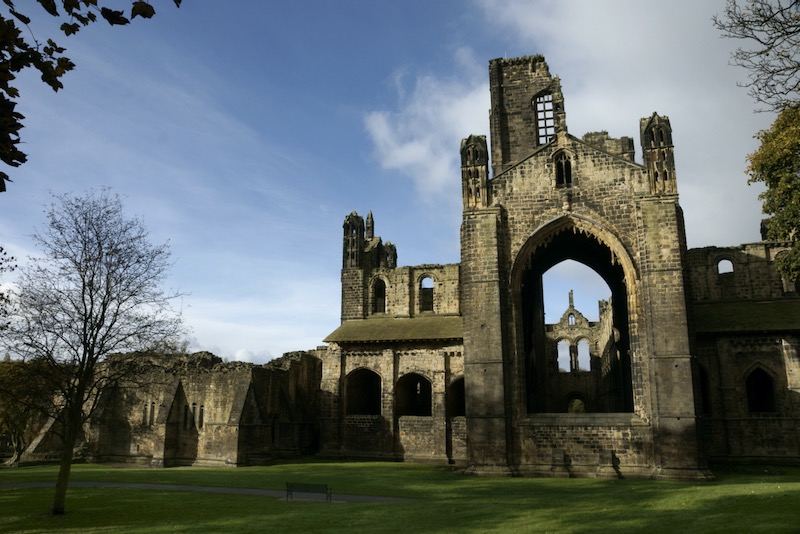Lockdown 3.0 shows no signs of being lifted anytime soon. During my bleaker moments, it all feels like an interminable Sunday afternoon in the 1970s, the joylessness and crushing boredom of which frequently overwhelmed the vividness of my childhood imagination. The emptiness of those dead hours is still etched into my memory 50 years later.
Very occasionally, a happy coincidence of good weather and my parents having a few quid to spare, provided the opportunity for a day trip to the limited number of attractions open on a Sunday and accessible by bus from our home in an outer suburb of Leeds. It helped a lot if the chosen destination was free. Hence on multiple occasions we ended up at the ruins of Kirkstall Abbey, four or so miles from Leeds city centre.
Indeed, one of my earliest memories – I can’t have been more than two or three at the time – is of quaffing orange squash (it was the 1970s) in the onsite café, only to react with horror and disgust on learning that this was located in the toilet block of the medieval monastery.
But these trips also had a much more positive impact. Indeed, I don’t doubt for a second that it was these early childhood visits to Kirkstall that set me on the path to becoming a monastic historian in adult life.
I couldn’t have hoped for better inspiration. Although not as famous or visited as the ruins of Fountains, Rievaulx or Whitby, Kirkstall is nevertheless one of the best-preserved monastic ruins anywhere in England. The church still stands to its full height, so do many of the buildings around the cloister, some even retaining their original stone vaulted ceilings. The abbey’s beauty is such that it’s easy to block out the noise of the traffic on the busy A-road that runs right past the ruins and to forget that rows of back-to-backs are only a stone’s throw away.
The abbey’s history goes back to 1147 when a colony of austere white-clad Cistercian monks left Fountains Abbey to found an off shoot, or “daughter house”, at Barnoldswick in the hills between Yorkshire and Lancashire. This site may have provided the remoteness so esteemed by the Cistercians but it was unsuitable in numerous other ways. For a start, the locals were none too chuffed about the clearance of their village to make way for the monks, appealing to Rome about this forced eviction.
The Pope sided with the monks, but contemporaneous sources recount the nascent community’s numerous other travails, including the “importunity of the clouds” and the danger of robbers. Under the leadership of Abbot Alexander, the monks therefore upped sticks and moved to a more congenial site on the banks of the river Aire, known to history as Kirkstall.
Here the monks prospered and by the end of the twelfth century had erected fine stone buildings. Although always a mid-ranking abbey, Kirkstall nevertheless enjoyed the patronage of local elites who eagerly sought the privilege of burial within its walls and the prayers of the monks for the salvation of their souls. At its height in around 1230, the community would have comprised as many as 50 monks and 100 lay brothers.
Like most other monasteries, Kirkstall had its ups and downs. Mismanagement of its economy meant that at the end of the thirteenth century it was almost £6000 in debt, a colossal sum at the time. A century later, repeated visitations of the plague, dilapidations due to warfare with the Scots and a lack of ready cash meant that there were a mere 16 monks and a handful of lay brothers at the abbey.
A period of slow recovery followed. At the turn of the sixteenth century the monks felt sufficiently confident about their future to give the abbey’s cathedral-like church a major makeover. This included the insertion of an enormous east window and the heightening of the bell tower. The size of the community increased to thirty or so monks. With an income of more than £400 a year, Kirkstall was one of the larger and richer Cistercian abbeys in late medieval England.
However, the abbey was soon caught up in Henry VIII’s Dissolution of the Monasteries, its end coming on 22 November 1539. Just two days before this cataclysmic event William Matthew, a dyer of Leeds, left the monks 13s to sing for his soul, poignant evidence of the enduring religious relevance of the abbey.
The dispersed monks kept in touch with one another. Their number included Edward Heptonstall who rescued a sizeable portion of the abbey’s library in the hope that his monastery would be refounded. It wasn’t to be. The abbey’s estates were sold off, its buildings wrecked and a highway was even driven through the shell of the ruinous church. By 1700 this was in a perilous state. Part of the bell tower collapsed, so too the hitherto complete west range.
Well into the nineteenth century the abbey’s setting retained the bucolic seclusion that had attracted the monks in the first place. The artists who flocked to Kirkstall’s picturesque ruins included none other than JMW Turner. But by the late Victorian age an industrial suburb of Leeds was encroaching on the surrounding parkland. Its then owner, Colonel John North, presented the site to the local council for the enjoyment and edification of the citizens of Leeds.
The intact twelfth-century gatehouse, a private house since the Dissolution, was converted into a museum. My paternal grandfather, William Carter, was its custodian in the years after the war and helped build what’s arguably the museum’s most famous attraction, a recreated Leeds street of around 1900. One of the shops – a glover and hosier – was named in honour of my paternal great-grandmother, Ann Carter.
My granddad’s job involved frequent nightshifts, and my dad, Neil, then a constable in the Leeds police, would drop in for a cuppa and a well-earned rest while pounding his lonely midnight beat.
I’ve a feeling my granddad welcomed the company and often brought his pet Pekingese dog (it rejoiced in the name Pizzicarter, get it?) with him when working nights. You can probably guess where I’m going with this. According to a credible local tradition, the last abbot of Kirkstall, John Brown, is said to have retired to the gatehouse after the Dissolution, where he died in around 1563. His ghost is purported to haunt the gatehouse’s upper chamber. On an early visit to the abbey I was shown the staircase leading to this room, which I was told, my granddad’s dog would never ascend. Rather, it sat beneath the worn twelfth-century steps quaking and snarling in fear. My childhood imagination provided a ready explanation.
That’s pretty much my scholarly interests summed up, isn’t it? The Cistercians, monastic history, art and architecture and the English ghost story tradition. And it’s all down to those trips to Kirkstall, which were made all the more special because they were in the company of my loving mum, dad and brothers. Perhaps Sundays in the 1970s weren’t that bad after all.



 Loading ...
Loading ...
What do you think?
You can post as a subscriber user ...
User comments (0)